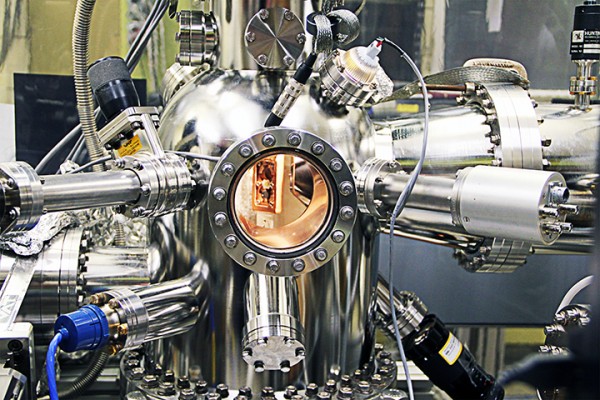Homegrown Solution for Synchrotron Light Source

Advances in angle-resolved photoemission spectroscopy (ARPES) help scientists at the U.S. Department of Energy's Ames Laboratory study electronic properties of new materials.
It’s often said that necessity is the mother of invention. Such was the case for Ames Laboratory physicist Adam Kaminski who took the research challenge he was facing and turned it into a new solution that will help advance his research.
Two years ago the National Science Foundation closed the synchrotron in Stoughton, Wisc. More recently, Brookhaven National Lab closed its synchrotron light source to make way for a more advanced and powerful facility. Concerned that this would leave him without the low-energy light source he needed to study the electronic properties of new materials, he improvised, and the result was the development of a new technique that provides a home-grown, laboratory-based solution.
Kaminski uses a technique called angle-resolved photoemission spectroscopy (ARPES) in which light energy (photons) is directed at a sample being studied. The photons cause electrons in the sample to be emitted into a vacuum. An electron analyzer measures the energy and momentum of these electrons, providing details about the electron properties within the material.
Besides using synchrotron beam lines, lasers can provide the input energy needed, but there were problems with the existing technology. High-energy, tunable lasers offered variable phonon energy, but lacked the resolution necessary for good results. Low-energy lasers provided excellent resolution but the fixed photon energy limited their usefulness.
So Kaminski, who admittedly knew little about lasers, set about finding a way to make a low-energy laser that was tunable. In searching the literature, he found that such a tunable laser had been suggested, but had never been used in ARPES systems. The laser used a potassium beryllium fluoroborate (KBBF) crystal to quadruple the frequency of infrared laser converting photons to the required “vacuum ultra-violet (UV)” range.
Obtaining such a crystal wasn’t easy. Kaminski found that the main source for the KBBF crystals, China, had embargoed their export. However, he found a research group at Clemson University that was able to grow him the crystal he needed. He was also able to obtain funding through the DOE Office of Science to build the new system. As an added bonus, the crystal growth and preparation was commercialized by Advanced Photonic Crystals, LLC. This will make them available in U.S. for applications such as UV photo lithography, spectral analysis and defense.
In simple terms, Kaminski’s system uses a pair of lasers, with the first acting as a pump for the second one. The resulting beam consists of very short pulses (one quadrillionth of a second) and very high (400 kW) peak power and is directed into a vacuum chamber that contains lenses, mirrors and the above mentioned “magic” crystal. This process quadruples the energy of the photons. By tuning the wavelength of the second laser and rotating the crystal, one can then tune the energy of the produced UV photons. The beam is then focused at the sample in an ultra-high vacuum chamber and a connected electron analyzer measures the electrons emitted from the sample.
“Development of a laboratory-based solution was really important,” Kaminski said. “Our beam is smaller, photon flux is higher by one or two orders of magnitude, and energy resolution is better by a factor of 5.”
For certain experiments, such as Kaminski’s, that can translate into significantly better data. As illustrated by the graphs (directional), synchrotron results of magnesium diboride show a surface band that curves relatively smoothly. Results from the tunable laser ARPES shows a dramatically enhanced plot with a sharp peak and a slight dip before leveling off.
“Our system has significant advantages,” Kaminski said. “It offers much higher resolution. When a researcher has a sample they want tested, we can usually do it the next day. ”
Kaminski has performed ARPES measurements for a number of research groups at Ames Laboratory as well as researchers at Sandia National Laboratory and Princeton.
“It’s great to have the capability to perform measurements right here in the Lab,” he said, “and it’s busy 24/7!”
This work was supported by the DOE Office of Science.
Ames Laboratory is a U.S. Department of Energy Office of Science national laboratory operated by Iowa State University. Ames Laboratory creates innovative materials, technologies and energy solutions. We use our expertise, unique capabilities and interdisciplinary collaborations to solve global problems. DOE’s Office of Science is the single largest supporter of basic research in the physical sciences in the United States, and is working to address some of the most pressing challenges of our time. For more information, please visit science.energy.gov.
DOE’s Office of Science is the single largest supporter of basic research in the physical sciences in the United States, and is working to address some of the most pressing challenges of our time. For more information, please visit science.energy.gov.
Contact Information
Breehan Gerleman Lucchesi
Communications specialist
breehan@ameslab.gov
Phone: 515-294-9750
Media Contact
All latest news from the category: Materials Sciences
Materials management deals with the research, development, manufacturing and processing of raw and industrial materials. Key aspects here are biological and medical issues, which play an increasingly important role in this field.
innovations-report offers in-depth articles related to the development and application of materials and the structure and properties of new materials.
Newest articles

NASA: Mystery of life’s handedness deepens
The mystery of why life uses molecules with specific orientations has deepened with a NASA-funded discovery that RNA — a key molecule thought to have potentially held the instructions for…

What are the effects of historic lithium mining on water quality?
Study reveals low levels of common contaminants but high levels of other elements in waters associated with an abandoned lithium mine. Lithium ore and mining waste from a historic lithium…

Quantum-inspired design boosts efficiency of heat-to-electricity conversion
Rice engineers take unconventional route to improving thermophotovoltaic systems. Researchers at Rice University have found a new way to improve a key element of thermophotovoltaic (TPV) systems, which convert heat…



